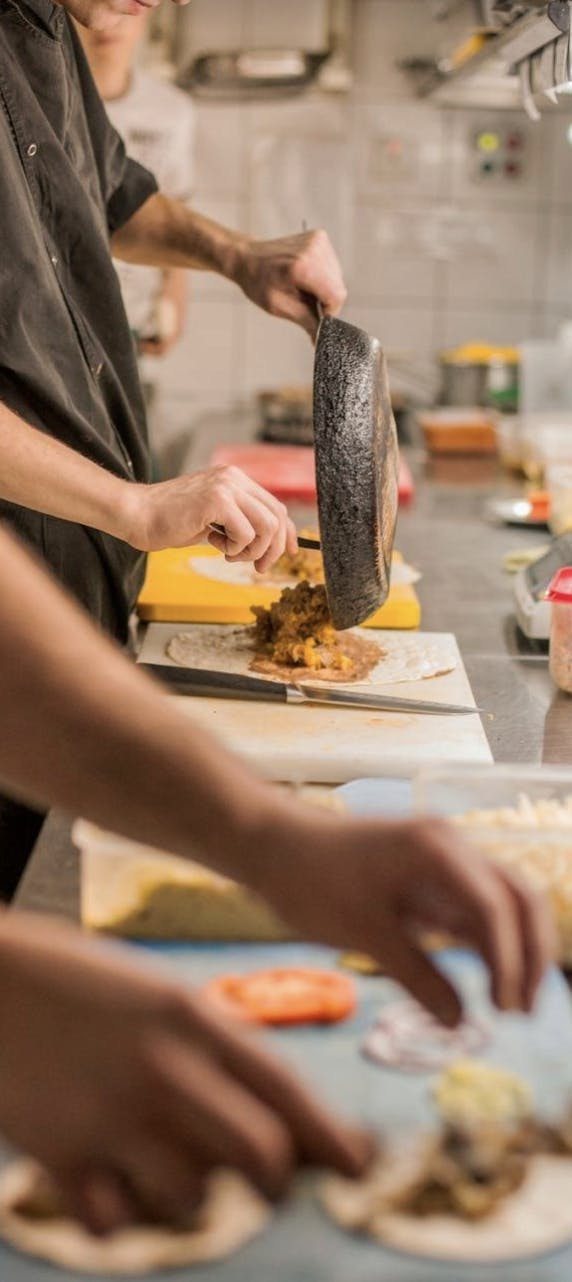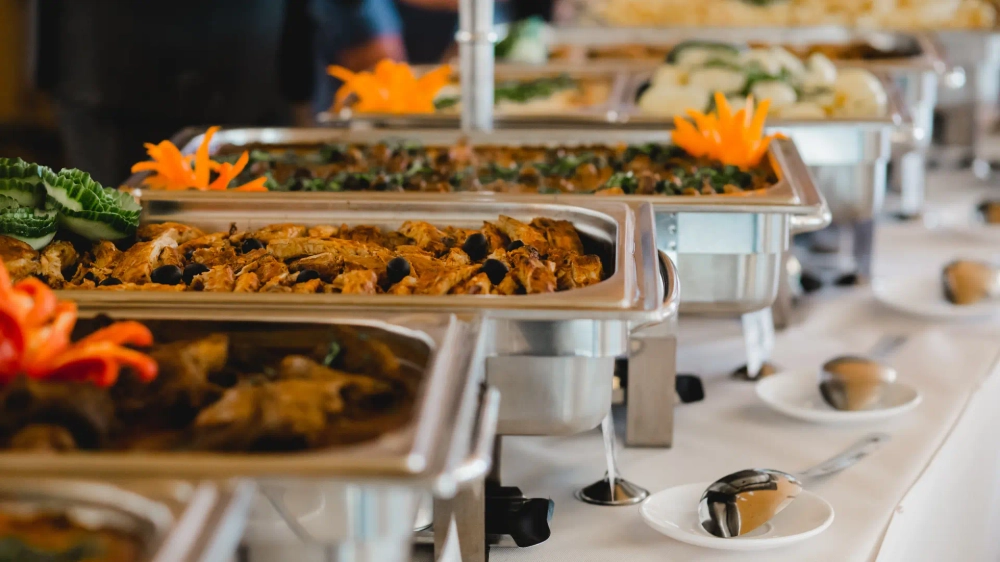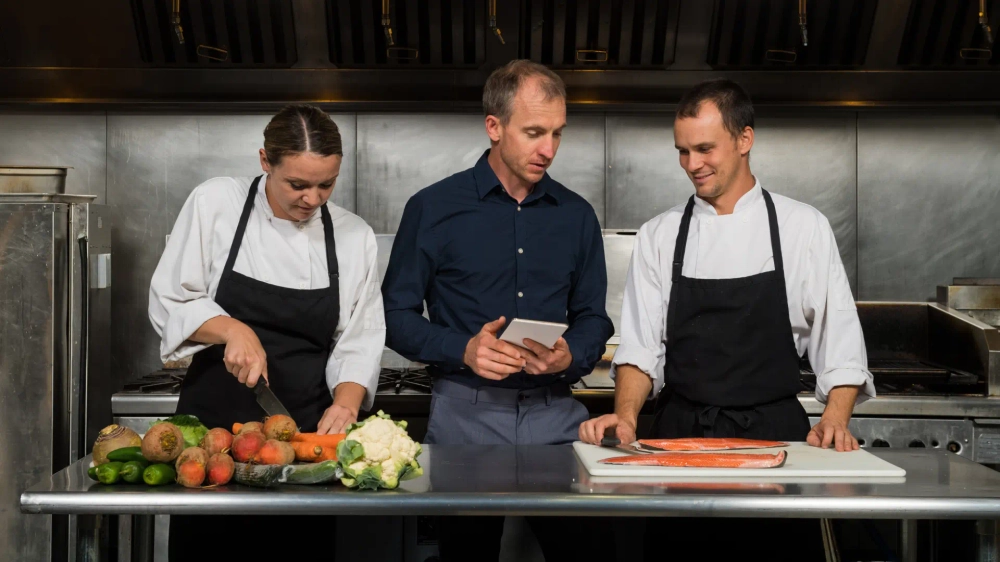13 steps on how to start a catering business
Table of Contents
CloudKitchens
How many tacos can be delivered from a 1000sqft restaurant?
The same amount as a 200sqft ghost kitchen.

From business gatherings to birthday parties, the most memorable events in life often have one thing in common: a seamlessly catered culinary experience.
Data agrees that catering is in demand now more than ever—one survey found an overwhelming 92% of caterers experienced revenue growth in 2022. Yet despite the clear profit potential, figuring out how to start a catering business is often the real challenge.
Whether you’re a seasoned chef or a budding restaurateur, read on for a comprehensive guide of everything you need to go from catering concept to thriving enterprise in 8 steps.
Step 1: Find your niche
Launching a successful catering business begins with some detective work. Consider both your target market and how your offerings fit into it. This will help you decide on factors such as:
- Catering type – Will you primarily cater corporate events, concessions at public venues, or weddings and social gatherings?
- Level of service – Do you intend to focus on food prep and delivery, or will you handle everything from setup to cleanup?
- Menu concepts – Are there any local market gaps that can set your service apart, like ethnic specialties?
Such market research establishes a critical foundation, enabling informed decisions for the steps that follow.
Step 2: Choose between on-site or off-site catering
When launching your catering business, one of the biggest decisions you’ll face is selecting between on-site and off-site catering. Each approach has its unique advantages and challenges, and understanding these can help you align your services with your business goals and client expectations.
With on-site catering, the food is made and served right at the event. This setup works well for venues that already have a kitchen, like banquet halls or hotels. It gives you the chance to serve hot food straight from the stove and make small changes on the spot, like adjusting portion sizes or handling last-minute requests.
On the flip side, it usually means hauling equipment to the site, working closely with the venue staff, and being ready for whatever space limitations or surprises the location might bring.
Off-site catering means you prepare the food in your kitchen and transport it to the event. This is common for events in backyards, parks, or spaces that don’t have a kitchen. It gives you more control over how and when everything gets cooked, and can make it easier to handle more than one event at a time.
But it also means you have to plan carefully so the food travels well and arrives ready to serve, which can be tricky if the event is far away or the weather doesn’t cooperate.
Some catering businesses do both, depending on the type of event or what the client needs. There’s no single right answer, what is important is to choose the setup that fits your skills, your space, and how you plan to work.
Step 3: Know the laws regarding on-site or off-site catering in your area
Before you start cooking for clients, it’s important to check the local rules for running a catering business, especially if you’re working from home or transporting food. Health departments in each city or state may have different requirements depending on where and how you prepare your meals.
If you’re cooking at home, you’ll likely need to register your kitchen as a business and meet food safety standards that go beyond everyday cooking.
Some areas may require a separate kitchen space that’s used only for catering operation, while others may allow shared use with proper cleaning and storage routines. You might also need food handler certifications or inspections before you’re allowed to serve customers.
If you’re preparing food off-site and delivering it to events, you’ll need to understand how to store, transport, and serve it safely. This could include having the right kind of containers, keeping food at save temperature during delivery, and following rules around labeling and traceability.
The best way to start this step is to contact your local health department or small business office. They can tell you what’s required in your area so you can start with confidence and avoid fines or delays down the line.
Step 4: Develop a business plan and secure funding
One study found that startups with a business plan are 16% more likely to succeed, and catering businesses are no exception. When writing a business plan, aim to include details such as:
- An executive summary of your business idea and goal
- Research on your target market and competition
- Plans detailing your operations, financial projections, and marketing initiatives
Since opening a catering business costs close to $50,000 on average, a comprehensive business plan is essential for winning over potential investors or lenders.
Step 5: Understand the main costs of starting a catering business
Starting a catering business doesn’t have to break the bank, but it’s important to know where your money will go from the beginning. Here are some of the main costs you’ll likely run into as you set things up:
Kitchen equipment
Whether you’re cooking from home or renting a commercial kitchen, you’ll need basic tools like ovens, stoves, refrigerators, mixers, knives, cutting boards, and pans. Some items you may already have, but others, like large-capacity gear, can be pricier and might require a bigger upfront investment.
Licensing and permits
Before serving your first customer, you’ll need the right paperwork. This often includes a business license, food handler certification, and possibly a health inspection, depending on your location. These costs vary a lot depending on the state or city you’re in, so it’s worth checking early.
Ingredients and packaging
Your food is your product, so you’ll need to budget for quality ingredients, and the containers, trays, or boxes that go with them. If you’re delivering meals or serving buffer-style, you’ll also need disposable cutlery, napkins, and storage options to keep everything fresh and safe.
Transportation
If you’re handling off-site catering, a reliable vehicle is key. That might mean using your own car at first, but you’ll still need insulated containers or coolers to keep food at the right temperature. As your business grows, you might consider investing in a dedicated delivery van.
Even if you are doing on site-catering, you should consider costs to transport safely the equipment needed and staff.
Marketing and branding
Getting your name out there is part of the job. You’ll want a simple website, maybe a logo, and some social media presence to start attracting customers. Even basic branding, like business cards or branded menus, can help make a strong first impression.
Step 6: Define your business structure
Once you’ve figured out what kind of catering you’ll offer and how much it’ll cost to get started, it’s time to decide how your business will be structured.
This step may not feel as exciting as choosing your menu, but it’s what makes everything legal and official, and it can affect how you pay taxes, handle paperwork, and protect your personal assets.
Many small catering businesses start as sole proprietorships, which is the simplest option. You don’t need to file much paperwork, and you can report income on your personal tax return. But it also means you’re personally responsible if anything goes wrong financially or legally.
Another common choice is forming an LLC (Limited Liability Company). This structure separates your personal finances from the business, which can help protect your personal property in the business ever runs into trouble.
It’s a popular option for catering businesses because it offers more security without being overly complicated to set up.
If you’re going into business with a partner, you might set up a partnership, where both of you share responsibility and profits.
Or, if you’re planning something bigger right away, like hiring a full team or working with investors, a corporation might make sense, but that comes with more paperwork and ongoing requirements.
The right choice depends on how you want to run your business and whether you plan to grow over time. It’s a good idea to talk to an accountant or legal advisor to understand what works best for your situation.
Step 7: Acquire equipment and supplies
One of the biggest starting expenditures for caterers lies in acquiring cooking, refrigeration, and serving equipment. You might utilize a rental supplier for tables and dishware to keep initial costs low, even factoring these expenses into your overall catering service package.
Smaller catering operations may opt to source inventory from discount clubs like Costco, scaling up to commercial suppliers as the business expands.
Step 8: Design and price a mouthwatering menu
An enticing menu is central to a successful catering business, serving as both its soul and selling point. Unlike traditional restaurants, a catering menu must be adaptable to various events and customer needs.
Consider a few elements of a catering menu that captivates and sells:
- Core offerings, such as appetizers, main courses, sides, and desserts
- Service packages tailored to specific events, such as weddings or corporate functions
- Customizations that cater to a variety of dietary requirements
You’ll also want to determine a pricing strategy for your menu—one that allows you to remain competitive while still fostering a healthy profit margin.
Step 9: Take out food liability insurance
No matter how careful you are, things can go wrong when food is involved. Food liability insurance helps protect your business if a customer gets sick, has an allergic reaction, or if something goes wrong at an event, like damage property or an injury during setup.
At a minimum, most caterers need general liability insurance. If you work from home, you may also need extra coverage, and if you hire staff, workers’ comp might be required too.
It’s one of those things you hope never to use, but it’s important to have. A single mistake could be expensive and insurance helps you stay covered without risking your business.
Step 10: Study your supplier options
Reliable suppliers are key to running a catering business. You’ll need fresh ingredients, packaging, and possibly rental items like tables, dishes, or serving equipment, so it’s worth taking time to compare your options.
Look for vendors who are consistent, fairly priced, and easy to reach when you need to make changes or place last-minute orders. Some caterers work with wholesalers to save on bulk ingredients, while others prefer local markets for fresher, seasonal items.
It’s also smart to have a backup or two in case your main supplier runs out of something. Building good relationships from the start can save you a lot of stress later on, especially during busy event seasons.
Step 11: Recruit and train your team
As your catering business grows, so will the need for a skilled and reliable team.
Look for passionate individuals who align with your business’s values and goals. Such intrinsic motivation is often more crucial than immediate skill, as it fuels the desire to learn and excel.
To that end, you’ll also want to incorporate an in-depth onboarding program and regular training sessions, ensuring your high standards of service are upheld.
Step 12: Obtain licenses and permits
When running a catering business, you must comply with local health department regulations and obtain the necessary licenses and permits. These may include:
- Food handler’s permit
- Health department permit
- Business license
Requirements differ by area, so be sure to research whether you have all the necessary documentation before launching your business.
Step 13: Market your business
To attract clients, advertising is key. According to one survey, the top sources of leads for caterers are:
- References – High-quality service naturally leads to locals spreading the word about your business.
- Relationships – Networking with businesses in adjacent sectors, like event planners and wedding coordinators, can promote organic growth.
- Reviews – A responsive digital presence and positive online reviews are strong drivers of new leads.
Combining online outreach with direct networking can help you build a strong client base and enhance business visibility.
Scale your operations with a ghost kitchen
Ultimately, the recipe for a successful catering business boils down to planning, hard work, and a dash of passion. But as your catering business grows, you may need help scaling operations due to limited kitchen space or rising rental costs.
That’s where ghost kitchens come in.
Ghost kitchens, also known as virtual or dark kitchens, are commercial spaces designed specifically for food businesses to prep meals for delivery or catering. With a ghost kitchen provider like CloudKitchens, you can streamline operations and expand your catering services—all without the hassle and overhead of a brick-and-mortar location.
Consider partnering with CloudKitchens so you can focus on what you do best: delivering delicious meals and top-notch service to your clients.
See locations in your area and get started today.
Explore ghost kitchen locations across the US:
- Ghost kitchens in Seattle
- Ghost kitchens in San Francisco
- Ghost kitchens in LA
- Ghost kitchens in NYC
- Ghost Kitchens in Toronto
- Ghost Kitchens in Atlanta
- Ghost Kitchens in Dallas
- Ghost Kitchens in Chicago
- Ghost Kitchens in Denver
- Ghost Kitchens in Miami
| DISCLAIMER: This information is provided for general informational purposes only and the content does not constitute an endorsement. CloudKitchens does not warrant the accuracy or completeness of any information, text, images/graphics, links, or other content contained within the blog content. We recommend that you consult with financial, legal, and business professionals for advice specific to your situation. |
Read more:
- How to Start a Food Business: The Ultimate Checklist
- Start a food delivery service: your complete how-to guide
- The Inside Scoop on Starting a Food Truck in the U.S.
- How to Start a Ghost Kitchen: Essential Tips for Success
- Start your Virtual Restaurant: The ultimate success blueprint
Sources:
Nuphoriq. Catering Industry Statistics. https://nuphoriq.com/catering-stats/
Harvard Business Review. Writing a Business Plan Makes Your Startup More Likely to Succeed. https://hbr.org/2017/07/research-writing-a-business-plan-makes-your-startup-more-likely-to-succeed
Starter Story. How Much Does It Cost To Start A Catering Business? (In 2024). https://www.starterstory.com/ideas/catering-business/startup-costs
Catering By Design. Everything You Need to Know About Catering. https://www.catering-by-design.com/blog/everything-you-need-to-know-about-catering/
More insights & stories
There’s more where that came from.
Get in the know and check out our additional insights


